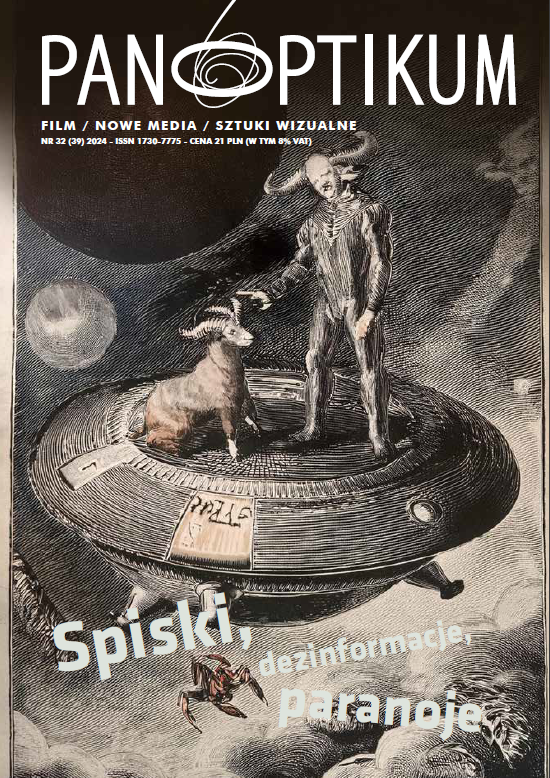Spiski możnych i uprzywilejowanych. Cal noir i narracja konspiracyjna
DOI:
https://doi.org/10.26881/pan.2024.32.02Słowa kluczowe:
Cal noir, narracje paranoiczne, elity, kino amerykańskieAbstrakt
One of the cinematic phenomena that laid the foundation for modern conspiracy narratives is film noir, where an outsider, not identifying with the optimistic vision of America, begins an investigation from a small case, and eventually reaches the heights of influence–into the gray areas of hidden power. In this way, noir fits into the category of conspiracy narratives, related to the plots of the powerful, now referred to as the “one percent.” A specific subgenre of film noir, in which this element is almost defining, is Cal noir where, under the scorching sun of the happiest state, Byzantine intrigues of the wealthiest unfold, and they are never punished. From Howard Hawks’ The Big Sleep to I Am the Night by Patty Jenkins and Sam Sheridan, Cal noir–sometimes based on true stories–explores, in an atmosphere of paranoia and fears related to the (conspiratorial) informal power held by elites who abuse it, corrupting both themselves and society.
Downloads
Bibliografia
Adlerberg, S. (2018). Literary Stoner Noir. Do Some Damage. http://www.dosomedamage.com/2018/12/literary-stoner-noir.html (dostęp: 7.09.2024).
Chandler, R. (1983). Skromna sztuka pisania powieści kryminalnych, [w:] D. Gardiner, K.S. Walker (red.), Mówi Chandler, przeł. E. Budrewicz. Warszawa: Czytelnik.
Chandler, R. (2001). Głęboki sen, przeł. J. Niedzielska. Warszawa: Warszawskie Wydawnictwo Literackie MUZA.
Christopher, N. (2006). Somewhere in the Night. Film Noir and the American City. Emeryville: Shoemaker & Hoard.
Dixon, W.W. (2009). Film Noir and the Cinema of Paranoia. Edinburgh: Edinburgh University Press.
Donovan, W. (2018). Conspiracy Films: A Tour of Dark Places in the American Conscious. Jefferson: McFarland & Company.
Elias, T. (2003). Paranoia, [w:] P. Knight (red.), Conspiracy Theories in American History: An Encyclopedia. Santa Barbara–Denver–Oxford: ABC Clio.
Eco, U. (1987). Metafizyka powieści kryminalnej, [w:] idem, Imię róży, przeł. A Szymanowski. Warszawa: PIW.
Elsaesser, T. (2018). Kino gier umysłowych, przeł. M. Przylipiak, [w:] M. Przylipiak (red.), Kino – maszyna myślenia. Refleksje nad kinem epoki cyfrowej. Gdańsk: Wydawnictwo Uniwersytetu Gdańskiego.
Gieba, K. (2015). Zwroty ku przestrzeni w badaniach literackich – próba uporządkowania pojęć i podstawowe rozróżnienia. „Przestrzenie Teorii”, nr 23.
Melley, T. (2000). Empire of Conspiracy. The Culture of Paranoia in Postwar America. New York: Cornell University Press.
Ostaszewski, J. (2018). Historia narracji filmowej. Kraków: Universitas.
Porfirio, R. (1977). Motywy egzystencjalne w hollywoodzkim „czarnym filmie”, przeł. P. Kamiński. „Dialog”, nr 5.
Rybicka, E. (2012). Geopoetyka, [w:] M.P. Markowski, R. Nycz (red.), Kulturowa teoria literatury. Główne pojęcia i problemy. Kraków: Universitas.
Schatz, T. (1981). Hollywood Genres. Formulas, Filmmaking and the Studio System. New York: McGraw-Hill.
Wasson, S. (2020). The Big Goodbye. New York: Flatiron Books.
Williams, T. (2013). A Mysterious Something in the Light: Raymond Chandler: A Life. Chicago: Aurum Press.
Włodek, P. (2022). „Wszystko noir?”. O inspiracjach i wariantach – życie po życiu film noir. Kraków: Wydawnictwo Naukowe Uniwersytetu Pedagogicznego.

 Uniwersyteckie Czasopisma Naukowe
Uniwersyteckie Czasopisma Naukowe









